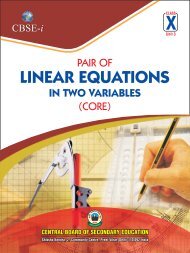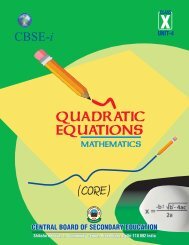CBSEi Class 10 Sequences (AP and GP) CORE
CBSEi Class 10 Sequences (AP and GP) CORE
CBSEi Class 10 Sequences (AP and GP) CORE
You also want an ePaper? Increase the reach of your titles
YUMPU automatically turns print PDFs into web optimized ePapers that Google loves.
– =<br />
= =<br />
=<br />
Thus, it is not an <strong>AP</strong> (Why?) [Note that denominators 7, 9, 11, 13,…. are in<br />
<strong>AP</strong>, check!!]<br />
(v) 1, 1.7, 2.4, 3.1,….<br />
We have,<br />
1.7 – 1 = 0.7<br />
2.4 – 1.7 = 0.7<br />
3.1 – 2.4 = 0.7<br />
So, it is an <strong>AP</strong> with common difference (d) = 0.7<br />
(vi) 1 2, 5 2, 7 2, 73,….<br />
1 2, = 1, 5 2 = 25, 7 2 = 49, 73 =73.<br />
Further,<br />
25 1 = 24<br />
49 25 = 24<br />
73 – 49 = 24<br />
So, 1 2 , 5 2 , 7 2 , 73,…. is an <strong>AP</strong> with common difference (d) = 24<br />
Example 5: Find the value of k for which k+2, 4k 6 <strong>and</strong> 3k 2 form three consecutive<br />
terms of an <strong>AP</strong>.<br />
Solution: a = k+2, a+d = 4k 6, a+2d = 3k 2, where d is the common difference.<br />
If k+2, 4k 6, 3k 2 are in <strong>AP</strong>, then<br />
d = (a+d) a = (4k 6) (k+2) = 3k 8 (1)<br />
Also, d = (a+2d) (a+d) = (3k 2) – (4k 6) = 4 k (2)<br />
47

















